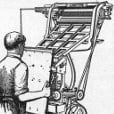Punchcutting: Literature

David MacMillan
Posts: 28
In another thread, Ramiro very kindly linked to my page on punchcutting literature at http://circuitousroot.com/artifice/letters/press/typemaking/literature/punchcutting/index.html But this threw me into an editorial panic, because there was a section there which was misleadingly out of date - the one having to do with the text of Jaugeon and the work of the "Bignon committee" for the Academie Royale in the 1690s. It's fixed now. The new page directly concerned with this work and its publication history is at: http://circuitousroot.com/artifice/letters/press/typemaking/literature/general/jaugeon/index.html
Briefly, in the 1690s a small group began a project for the Academie Royale which decades later was partially published as the "Descriptions des arts et metiers" (a project distinct from Diderot and d'Alambert's Encyclopedie). They began with the study of the making of type, in part because at the same time they were creating the type which has become known as the Romain du Roi. The manuscript that came out of this in 1704, along with several plates, is the second major work on type-making (after Moxon) and certainly the first well-illustrated work. But it was not published. 300 years later, it still hasn't been published. Portions of it have appeared (excerpts from the plates - especially James Mosley's 1991 reprint of them in Matrix 11 - and, importantly, Mosley's 2015 translation of the section on the hand mold), but it has been a difficult and sometimes expensive work to access in any way. Fortunately, a digital version of an 18th century copy of the MS, with plates, is now available freely online via the Gallica digital library of the Bibliotheque nationale de France. It's low-resolution, but the plates are legible and well worth your time.
More generally, on the subject of the literature of typographical punchcutting: what else is there (ancient or modern)? It is a body of literature that is small enough that we should be able to identify every work in every language in every tradition.
Briefly, in the 1690s a small group began a project for the Academie Royale which decades later was partially published as the "Descriptions des arts et metiers" (a project distinct from Diderot and d'Alambert's Encyclopedie). They began with the study of the making of type, in part because at the same time they were creating the type which has become known as the Romain du Roi. The manuscript that came out of this in 1704, along with several plates, is the second major work on type-making (after Moxon) and certainly the first well-illustrated work. But it was not published. 300 years later, it still hasn't been published. Portions of it have appeared (excerpts from the plates - especially James Mosley's 1991 reprint of them in Matrix 11 - and, importantly, Mosley's 2015 translation of the section on the hand mold), but it has been a difficult and sometimes expensive work to access in any way. Fortunately, a digital version of an 18th century copy of the MS, with plates, is now available freely online via the Gallica digital library of the Bibliotheque nationale de France. It's low-resolution, but the plates are legible and well worth your time.
More generally, on the subject of the literature of typographical punchcutting: what else is there (ancient or modern)? It is a body of literature that is small enough that we should be able to identify every work in every language in every tradition.
1
Comments
-
Hello David!
Thank you for all of the research you have compiled on your website. I learned about your site a few years ago, from Stephen Coles.
There are a few German-language articles published in late-nineteenth and early-twentieth century printing-trade periodicals that are not listed on http://circuitousroot.com/artifice/letters/press/typemaking/literature/punchcutting/index.html. While these articles do not have as much detail as I would like, I find that they have almost as much information as the articles by Rudolf Koch and Paul Koch. At least for my purposes; I am looking for statements about how letters are etched onto the face of the punch before cutting, and/or about transferring an image onto the face of a punch before cutting. I have not compiled a complete list of these articles yet myself; I’m still working on this, and will probably only really be complete in about 10 more months (I’m compiling more than just information on this topic …). Three articles that stand out for me are:
[Franz Max?] Schnögula and Albert Hoffmann: »Die Herstellung der Schrift von der Zeichnung bis zur Ablieferung an die Druckerei. Vortrag, gehalten von den Herrn Stempelschneider Schnögula vor der Berliner Typogr. Gesellschaft. Für das Journal bearbeitet von Albert Hoffmann.« In: Schlotke, Ferdinand (ed.): Journal für Buchdruckerkunst, Schriftgießerei und die verwandten Fächer. Vol. 50, no. 23, columns 491–495. Continued in vol. 50, no. 24, columns 509–512. Hamburg: Ferdinand Schlotke, Hamburg (1883). [Schnögula was a punchcutter and engraver in Berlin, but my information on him is almost non-existant; he died c. 1893, I believe.]
H. Röder: »Die Herstellung von Stempeln für Buchdrucktypen.« In: Archiv für Buchgewerbe. Vol. 38, p. 300–302. Leipzig: Verlag des Deutschen Buchgewerbevereins (1901). [As is the case with Herr Schnögula above, I do not yet have any biographic details for H. Röter.]
Heinrich Weber: »Wie entstehen unsere Lettern?« In: Klimsch’s Jahrbuch – Eine Übersicht über die Fortschritte auf graphischem Gebiete. Vol. 2, p. 37–46. Frankfurt am Main: Verlag von Klimsch & Co. (1901).
1
Categories
- All Categories
- 46 Introductions
- 3.9K Typeface Design
- 487 Type Design Critiques
- 567 Type Design Software
- 1.1K Type Design Technique & Theory
- 656 Type Business
- 862 Font Technology
- 29 Punchcutting
- 522 Typography
- 120 Type Education
- 325 Type History
- 77 Type Resources
- 112 Lettering and Calligraphy
- 33 Lettering Critiques
- 79 Lettering Technique & Theory
- 559 Announcements
- 94 Events
- 114 Job Postings
- 170 Type Releases
- 180 Miscellaneous News
- 276 About TypeDrawers
- 54 TypeDrawers Announcements
- 120 Suggestions and Bug Reports
